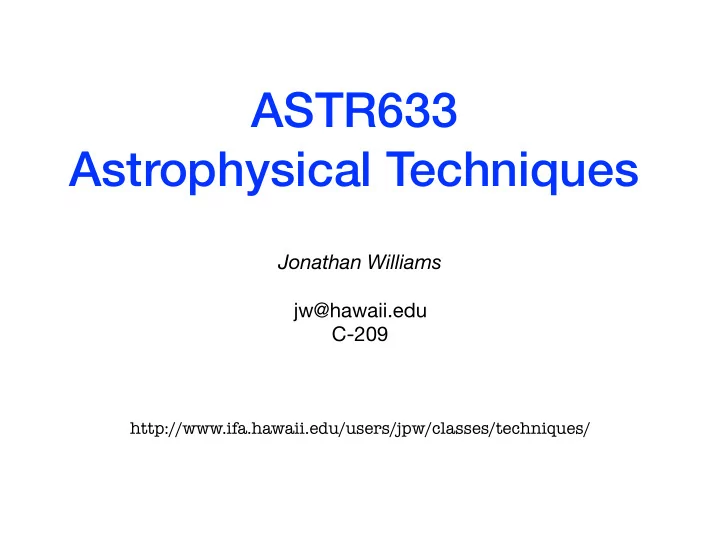

ASTR633 Astrophysical Techniques Jonathan Williams jw@hawaii.edu C-209 http://www.ifa.hawaii.edu/users/jpw/classes/techniques/
Who am I? - born in England a long time ago - 1988 BA mathematics @ Cambridge - 1995 PhD astronomy @ Berkeley (molecular clouds, star formation) - Postdocs, faculty jobs in MA/AZ/FL - joined faculty at UH in 2002 (my 6th university) - Became a US citizen in 2005 (after F , J, H visas, green card… total of 17 years) - Research interests: protoplanetary disks; planet formation; submillimeter interferometry and some IR imaging - Non-research interests: sailing and scouts (currently); travel and basketball (t < 35y) This summer, I went to a conference in Sweden, fished in Alaska and explored the Pacific NW with my family, and worked on an ISM textbook. In 10 years time, I hope I’m still getting invited to meetings and we have many more unambiguous signatures of protoplanets in disks.
Who are you? • Introduce yourselves • What did you do this summer? • What do you see yourself doing in 10 years?
Introduction to the course • “Astrotech” is currently the only required course for astronomy graduate students • Putting the fun in fundamentals… - how data are acquired and analyzed (less on physical interpretation - that’s for other classes) - “looking under the hood” of telescopes, instruments and software • Jack of all trades, master of none • You will use what you learn in this class in real life
Course format • 75 min classes each Wednesday and Friday (ends ≈ 2:15pm) - Mini-lectures - Discussion of assigned reading from course book - Detailed break down of problem sets • Class schedule on google calendar at class website Each student should be prepared to start a discussion in every class. If you don’t understand the basics, you should do some background research (look at other books, talk to other students/postdocs/faculty).
Course book - ASTR633 has a long history, taught by several faculty, in a very traditional lecture format. - This is the first time (second year) a course book has been used. - The goal is to “flip the classroom” through assigned reading and in-class discussion. - This requires active involvement from YOU! The more you give, the more you get
Active involvement - Over the semester, each student will lead two mini-lectures (~30 minutes) on topics of their choosing - Expand upon an area in the book or go beyond (but check with me first). E.g., - Details about a telescope / instrument - Specifics of a data reduction package - Sophisticated analysis techniques such as machine learning - Provide a short handout to distribute two days before class, i.e., Mon or Wed - This is a chance for you to delve deeper into an area of particular interest to you - No need to decide right away, but two must be done by the end of the semester for full credit
Grading • 60% on problem sets - Generally assigned every 1-2 weeks and due 1-2 weeks later - Hand in by the start of class on due date - Hard deadlines (like telescopes, grants, etc): 50% o ff if handed in by start of next class, no credit after that • 40% on class participation - Two mini-lectures and general contribution to discussion No final exam and no curve. If you get maximum grades on problem sets but do not show up, you’ll get a B. If you get the maximum for class participation but don’t do any problem sets, you’ll get a C.
Necessities • Course book • Computer access - There will be coding assignments - Use either IfA computers (e.g., galileo) or personal laptop - I recommend you code in python and use the jupyter notebook - If you don’t know coding (& python) yet, get up to speed asap. You will need it well beyond this class!
Resources • These and future slides will be posted at the course website • Course book and other useful books on hold at library • jupyter.org, stackoverflow.com, older students, other faculty • O ffi ce hours - After class (but not before…) - By appointment or just drop by and see if I’m in C-209 Along with the telescopes, the best perk of being a grad student at the IfA is that you can literally walk into the o ffi ce of an expert in almost any field. The most successful students talk to many faculty, not just their advisor!
Preface - “Progress in astronomy is fueled by new technological opportunities” - “Astronomy has become panchromatic” - “You can do good astronomy without being totally current in physics (but you need to know physics very well)” - “Technology changes rapidly and you absolutely must be up to date on it, or you will rapidly fall behind in the field”
Progress is fueled by technology The ≈ 2000 year old view of the Universe was shattered within a few years after the invention of the telescope
Detection of the CMB The beginning of radio astronomy Jansky 1932 Penzias and Wilson 1964 t ~ 100 years CMB Polarization 2020s… 2001-2010
2012 Andrews et al. 2016 (UH alumnus)
Panchromatic astronomy
You need to know (old) physics very well… Take a broad range of classes! Attend colloquia, astro-ph discussions, focus-group meetings, etc…
Chapter 1 Radiometry, optics, statistics • All we do is measure photons (until the last chapter at least…) • We can’t do controlled experiments to test causal relationships so we have to study samples statistically • Read Chapter 1, sections 1.1,1.2,1.3 by next class • Compare the dome sizes of Yerkes and Keck observatories on google maps. How big are the telescopes inside of each? Explain the di ff erence.
Recommend
More recommend